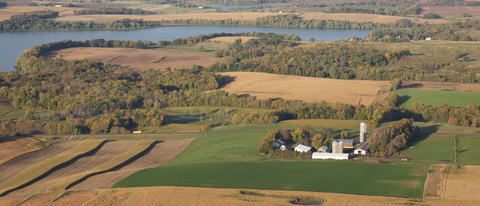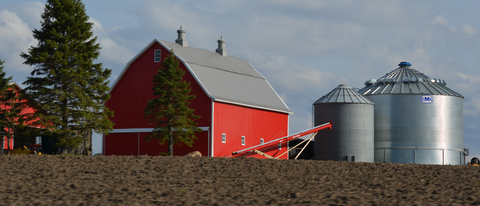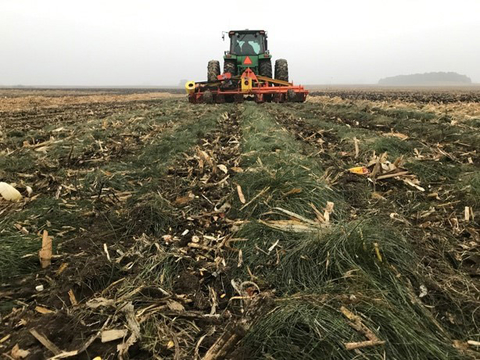Crops and animals affect water quality
Rainfall and snow melt running off farmland or seeping into the ground can carry pollution into lakes and streams. This pollution carried by runoff is called nonpoint source pollution.
In the past, nonpoint pollution from one farm or field has been easy to ignore as insignificant, but it can't be ignored any longer because the sum of the thousands of nonpoint pollution sources is the main cause of today's water quality problems.
Raising crops and animals can contribute to nonpoint pollution if runoff is not properly treated.
The sum of the thousands of nonpoint pollution sources is the main cause of today's water quality problems.
Sources of nonpoint pollution in Minnesota
Many different types of crop and animal operations contribute to nonpoint source pollution; from dairy and beef farms to sled dog kennels and hobbyhorse farms. These operations can create pollution in a number of ways:
- Sending nutrients and organic matter into surface water.
- Pasturing animals along stream banks can cause erosion that adds sediment to lakes and streams.
- Farming steep fields in continuous row crops can create sheet and rill erosion that strip away topsoil. The topsoil that ends up in lakes and streams often carries nutrients and pesticides along with it.
Major agricultural pollutants
The major nonpoint source pollutants are sediment, nutrients, pesticides, bacteria and oxygen-demanding substances.
- Sediment. Eroded soil particles from fields, ditches and streambanks make water turbid, damaging fish and plant habitat and reducing water's aesthetic appeal. This sediment may carry nutrients and heavy metals with it.
- Nutrients. Fertilizer or animal waste in runoff water delivers nutrients such as phosphorus and nitrogen to lakes and streams, causing excessive algae and weed growth. High nitrate concentrations in drinking water can present a health threat for infants.
- Pesticides. Agricultural chemicals such as insecticides or herbicides can wash off crops and fields into lakes and streams where they can be toxic to fish and other aquatic life. Some pesticides pose a threat to human health if they reach drinking water supplies.
- Bacteria. Runoff or seepage from feedlots and failing septic systems can carry coliform bacteria into surface and ground water, presenting health risks for drinking or body contact.
- Oxygen-demanding substances. Manure, sewage, crop residue and other decaying organic matter use up oxygen needed by fish.
Best management practices to prevent nonpoint source pollution
Minimize the impact of agriculture on nearby lakes and streams by using these best management practices (BMPs).
Control erosion on cropped land
Careful management of your tillage practice can lead to a more profitable farm operation, reduce erosion and improve water quality. Some tillage options to consider are:
- Mulch tillage.
- No-till and ridge-till systems.
- Contouring and grass field borders.
- Strip cropping.
Many operations still use the moldboard plow in a conventional tillage system. Consider these options to reduce erosion:
- Fall plowing heavy soils is the best option, but the ground should be left rough and cloddy. Winter conditions can help improve your soil structure by reducing the clump size. Leaving a rough surface also helps cut down surface erosion.
- Never disc a fall plowing unless it is early enough to establish a fall cover crop. Discing or making seedbeds in the fall will create the opportunity for significant soil and nutrient loss.
- Spring plowing is your best option in lighter soils and can reduce overall soil erosion.
Use basic best management practices to lessen your negative impact on water quality:
- Soil management.
- Crop rotation.
- Nutrient management.
- Seeding fragile and drainage areas with grass for sediment control.
Use diversions and roof gutters to control runoff
A diversion is a permanently vegetated ridge constructed at the base of a slope to safely divert the runoff. Gutters simply redirect significant amounts of water away from building foundations or, in this case, an animal barnyard.
Manage manure properly
Use a manure catchment
This structure allows for the buildup of manure and channels liquid manure to a single outlet. Liquid manure can be either stored and used to fertilize fields or "treated" by a grass filter strip. Solid manure within the catchment can be removed during the growing season and applied to the field, adding organic matter and nutrients. There are many designs and methods of storage for managing both solids and liquids.
Install a grass filter strip to filter nutrients
This is permanent grass sod that filters potentially harmful nutrients from the manure catchment area. In the growing months, excess nutrients can be utilized by the grasses. This method is enhanced by the addition of a buffer strip between the grass filter strip and the stream.
Maintain buffer strips along lakes and streams
Along lakes and streams, removal of excess nutrients can be enhanced by the use of buffer strips. These consist of natural or planted woody vegetation along the edge of the stream or lake. The buffer strip acts to:
- Stabilize soil.
- Trap nutrients by filtering runoff.
- Shade and cool the water to improve aquatic habitat.
The wider the buffer strip, the greater its effectiveness. Planting high value tree species could increase your farm's future value.
Install stream crossings and fencing to keep livestock away from stream
Low-flow gravel crossing. The least expensive method is to make a low-flow gravel crossing allowing livestock access to pasture on the other side of the stream.
Culverts and bridges. These are more costly but might be necessary in sensitive areas. These also can be built to allow machinery to cross.
Fencing. Fencing can be installed on either side of the crossing as gates to prevent them from walking along the stream. Fencing animals out of lakes or streams will prevent water pollution. Watering your animals can be done with electric pumps, solar-powered pumps, mechanical nose-pumps and stock watering ponds.
Permits may be needed for work done along streams or lakes.
Use intensive rotational grazing for pasturing livestock
Intensive rotational grazing provides better forage for your animals while improving sod and soil coverage between grazing cycles and can reduce overall erosion. Fencing animals from sensitive areas is also important.
Convert marginal fields to other uses
Highly erodible and marginal fields can be converted to various uses depending on your objectives. Changing marginal cropland or pastures can provide long-term benefits both financially and environmentally. Some conversion possibilities are:
- Intercropping trees and pasture.
- Planting nut trees or high quality timber.
- Planting Christmas trees.
- Using native and imported species for wildlife habitat.
Store fuel, fertilizer and pesticides safely
A small amount of fuel oil, gasoline, diesel, fertilizer or other chemicals can contaminate a large volume of water. Here are some suggestions:
Fuel oil, gasoline and diesel:
- Locate tanks away from other buildings and water.
- Dike the area around above-ground tanks to contain spills.
- Follow maintenance, safety and disposal precautions.
Fertilizer and other chemicals:
- Store only small amounts for short periods.
- Clearly mark containers and check their condition.
- Cover and store on a sealed surface to contain any spills.
- Properly dispose of outdated unused chemicals. Contact your county solid waste officer who may accept unused chemicals free of charge.
Contain silage/haylage properly
Improperly contained silage can contaminate ground and surface water. Use these basic best practices to minimize risk from these operations:
- Store silage away from any water source.
- Provide impermeable surface soil around the storage.
- Install a seepage collection system.
- Divert clean water away from area.
- Adequately cover silage.
Regulations that apply
Owners of feedlots with more than ten animal units are required to have a feedlot permit available from the MN Pollution Control Agency (PCA). Check with local zoning authorities for assistance.
Program assistance for agricultural BMPs
These agencies all offer programs to help people plan and adopt BMPs:
- Soil and Water Conservation District (SWCD).
- MN Board of Water and Soil Resources (BWSR).
- Natural Resources Conservation Services (NRCS).
- Farm Services Agency (FSA).
Through the SWCD, state and federal cost-share programs are available to help people apply these practices. Planning and design assistance is offered at no cost and up to 75% of the installation cost can be covered by cost-share dollars.
Reviewed in 2018





